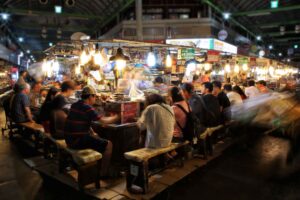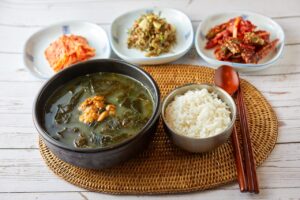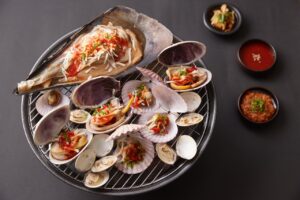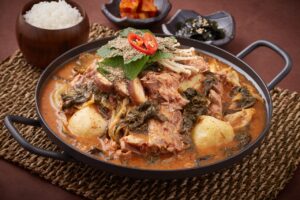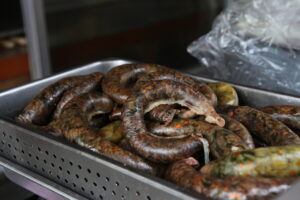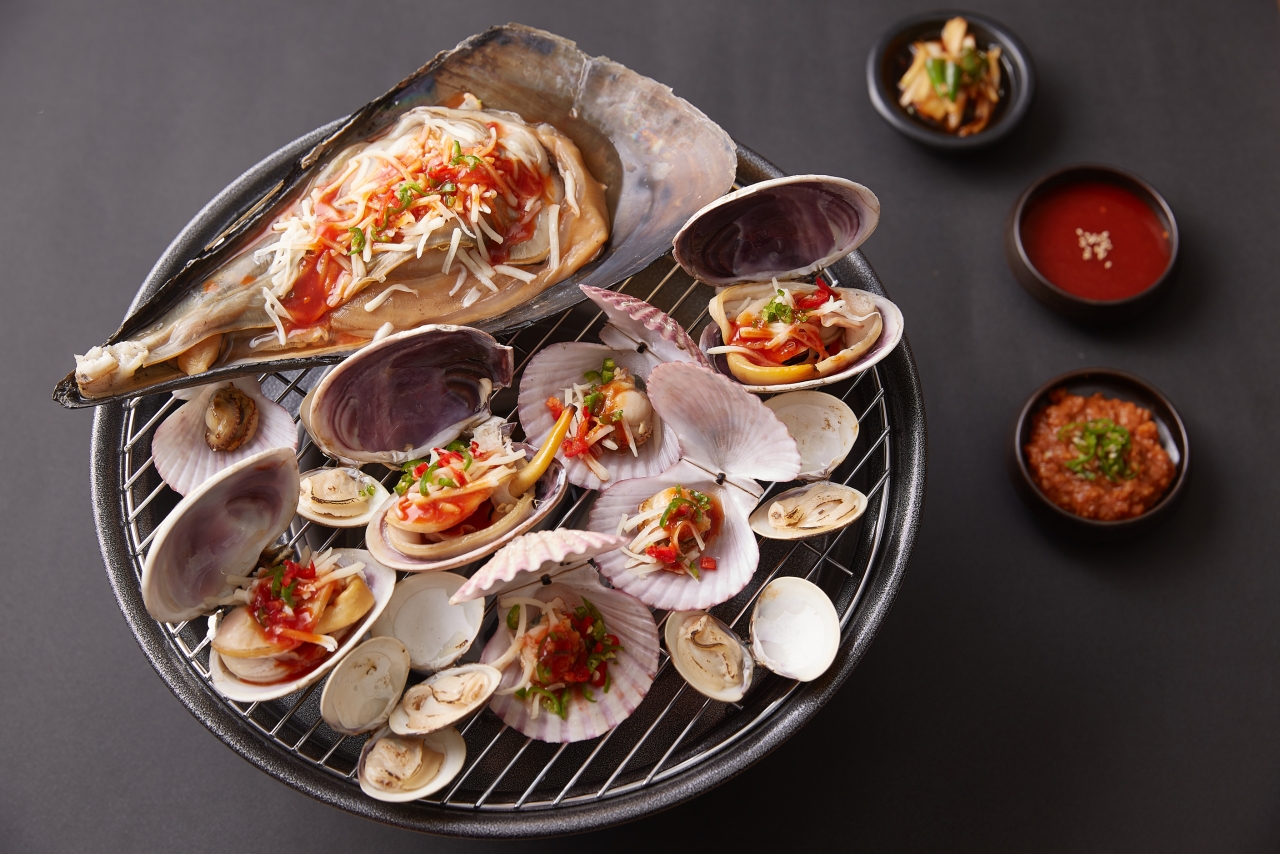
JogaeGui- ⓒ한국관광공사 사진갤러리 - 디그램
What is JogaeGui?
JogaeGui, also spelled as “Jogaegui,” is a popular Korean seafood dish that primarily consists of grilled or roasted shellfish. The term “Jogae” refers to various types of shellfish, including clams, scallops, mussels, and sometimes even oysters. These shellfish are typically seasoned with a mixture of garlic, ginger, soy sauce, sesame oil, and other flavorful ingredients before being cooked over an open flame or on a grill.
JogaeGui is known for its savory and slightly sweet flavor, often enhanced by the smokiness from the grilling process. It’s a favorite seafood dish in Korean cuisine and is often enjoyed as an appetizer or side dish, complementing other Korean dishes like barbecue (e.g., bulgogi) or served alongside rice and various banchan (side dishes). The exact preparation and seasoning of JogaeGui can vary depending on the region and the chef’s preferences, but it generally highlights the natural taste of the shellfish while adding delightful Korean flavors.
Jogae is common in Korea.
Korea’s long coastline and geographical location have contributed to the abundance of various types of seafood, including Jogae (shellfish), in Korean cuisine. Here are several factors that help explain why Koreans have a strong tradition of consuming Jogae and other seafood:
Coastal Location: Korea is a peninsula with an extensive coastline along the Yellow Sea and the East Sea (Sea of Japan). This coastal geography provides easy access to a wide variety of seafood, including various types of shellfish.
Fishing Tradition: Fishing has been an important part of Korean culture and livelihood for centuries. The Korean people have a long history of fishing in their coastal waters, which has helped make seafood, including shellfish, readily available.
Seasonal Availability: Shellfish, such as clams and mussels, are available year-round in Korea, making them a consistent and reliable source of protein for the Korean diet. Different species of shellfish are available in different seasons, ensuring a varied seafood selection.
Culinary Creativity: Koreans have developed a rich culinary tradition that showcases their creativity and ability to transform local ingredients into delicious dishes. This includes a wide range of preparations for shellfish, like JogaeGui, in various flavorful and inventive styles.
Health Benefits: Seafood, including shellfish, is known for its nutritional value and health benefits. Koreans have recognized the nutritional advantages of seafood and have incorporated it into their diet for its protein, omega-3 fatty acids, and other essential nutrients.
Cultural Significance: Seafood, including shellfish, holds cultural significance in Korean society. It is often a part of traditional Korean celebrations and is considered a symbol of abundance and prosperity.
Given these factors, the Korean people have developed a strong tradition of incorporating Jogae and other seafood into their diet, resulting in a wide array of delicious and culturally significant seafood dishes in Korean cuisine.
Kinds of Jogae in Korea.
Korea is known for its diverse selection of Jogae, which refers to various types of shellfish. Here are some common types of Jogae found in Korean cuisine: Geoduck (개불): Geoduck is a large saltwater clam with a long, neck-like siphon. It is typically sliced thin and enjoyed fresh, often served as sashimi or in salads.
Jogae (조개): The term “Jogae” itself is a general term that encompasses various types of shellfish. Common examples include clams, mussels, and scallops.
Gul (굴): Gul refers to oysters, which are often enjoyed grilled, in stews, or as a topping for rice dishes.
Manila Clams (바지락): These small, sweet clams are a popular ingredient in various Korean dishes, such as seafood stews and stir-fried dishes.
Blood Cockles (홍합): Blood cockles are known for their distinctive red coloring and are used in a variety of Korean dishes, including soups and rice dishes.
Sea Snails (소라): Sea snails are often enjoyed as a snack or appetizer in Korean cuisine. They are typically marinated or seasoned before consumption.
Scallops (가리비): Scallops are frequently used in dishes like JogaeGui (grilled shellfish) and are also included in various seafood stews.
Razor Clams (가두리): These long, slender clams are popular in Korean cuisine, particularly in grilled dishes.
Abalone (전복): Abalone is considered a delicacy in Korean cuisine and is often served in a variety of preparations, such as sashimi, porridge, and grilled dishes.
Cockles (소라): Cockles, similar to blood cockles, are used in various dishes, including seafood stews and salads.
These are just some examples of the many types of Jogae found in Korea. Each type of shellfish is used in various recipes and dishes, and the versatility of shellfish in Korean cuisine is a testament to the rich culinary traditions of the country.
Best Place in Korea
JogaeGui is a popular seafood dish in South Korea, and you can find it at various seafood restaurants and markets throughout the country. Some places are particularly famous for their JogaeGui due to the quality and freshness of the shellfish, as well as the skill of the chefs. Here are a few well-known places for enjoying JogaeGui in South Korea: Busan: Busan, a coastal city in South Korea, is renowned for its seafood, and you can find excellent JogaeGui restaurants in the Jagalchi Fish Market and other seafood markets throughout the city.
Incheon: Incheon, another coastal city, is also known for its fresh seafood. You can find JogaeGui restaurants in the Sinpo International Market and around the city’s coastal areas.
Jeju Island: Jeju Island, located off the southern coast of South Korea, is famous for its seafood, and you can enjoy JogaeGui with a view of the beautiful ocean at many restaurants on the island.
Seoul: While not as coastal as the previous locations, Seoul has a wide variety of seafood restaurants and markets where you can savor JogaeGui, often using seafood that has been transported from coastal areas.
Coastal Towns: In addition to the major cities, many smaller coastal towns and fishing villages along the South Korean coastline offer excellent JogaeGui due to their proximity to the sea.
When searching for a place to try JogaeGui, consider asking locals for recommendations or checking online reviews to find the best options for your taste and budget. Different restaurants may have their unique preparations and styles, so it’s worth exploring to find your favorite JogaeGui experience in South Korea.

Jogae Jjim
Jogae Jjim, also spelled as “Jogaegui Jjim,” is a popular Korean seafood dish that consists of steamed or braised shellfish. The term “Jogae” refers to shellfish, and “Jjim” means steamed or braised. Jogae Jjim is typically made with a variety of shellfish, such as clams, mussels, scallops, or other types of shellfish, depending on availability and preference.
The dish is known for its savory and aromatic flavors, often enhanced by a rich and slightly spicy sauce made from a combination of ingredients like garlic, ginger, soy sauce, red pepper flakes, and sesame oil. Vegetables like green onions and bell peppers are also commonly added to the mix, providing additional flavors and textures.
The cooking process involves steaming or braising the shellfish and the sauce together until the shellfish open up and become tender, absorbing the flavors of the sauce. Jogae Jjim is typically served as a main course or as part of a shared seafood feast, accompanied by rice and other side dishes. It’s a popular dish in Korean cuisine and is enjoyed for its delicious taste and the tender, flavorful shellfish.
…
…
…
Recommend to Read >>> Gamjatang
